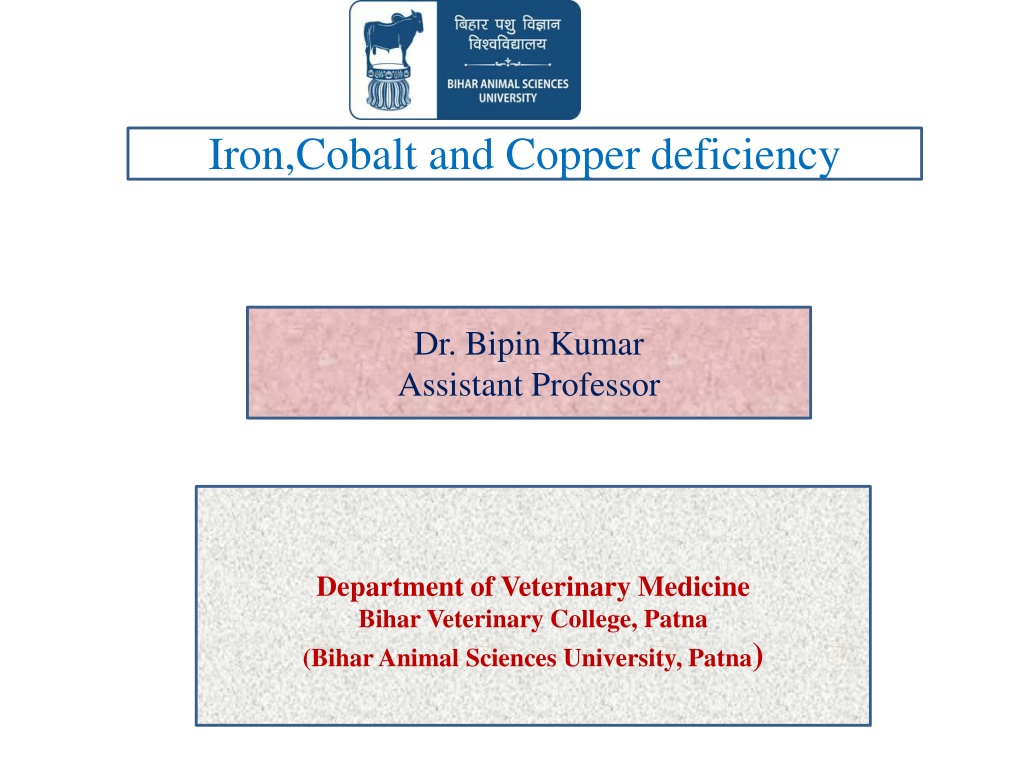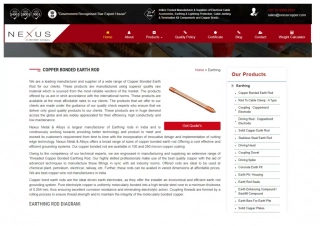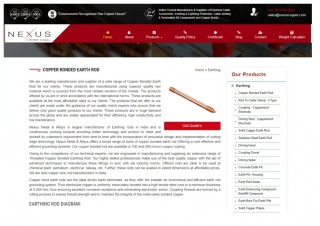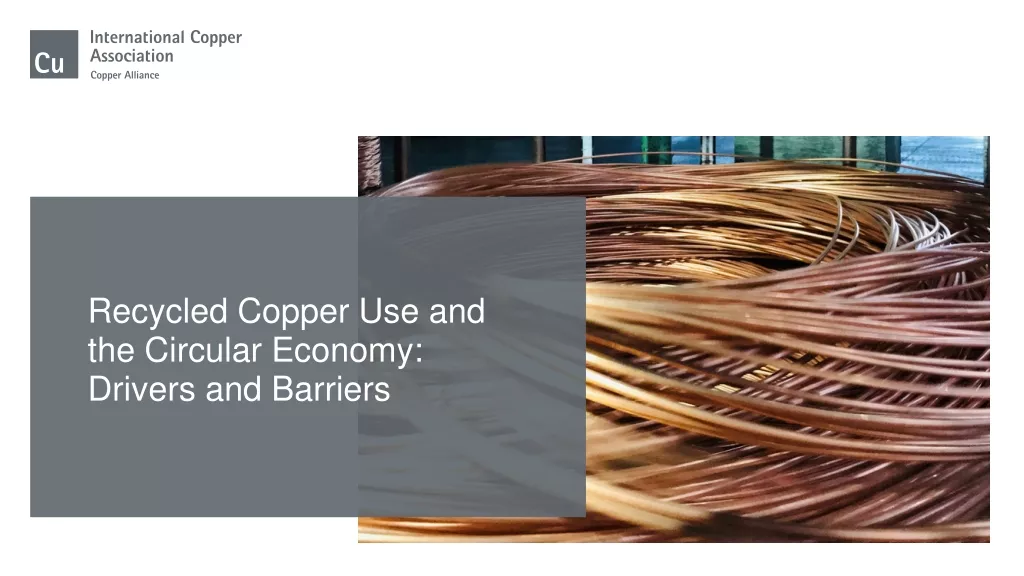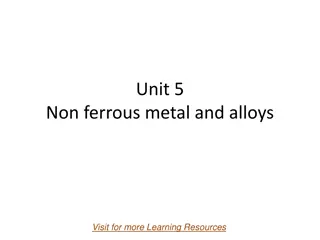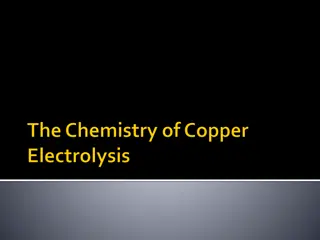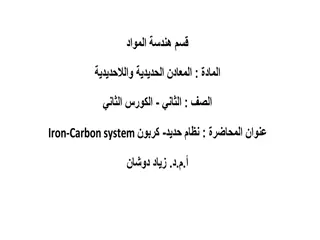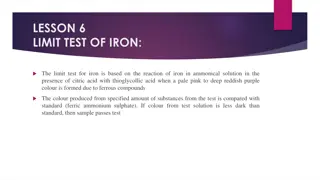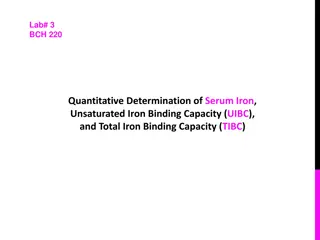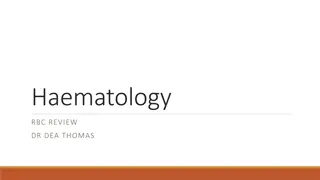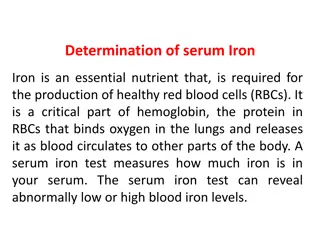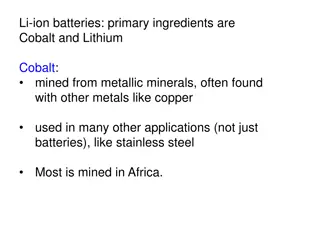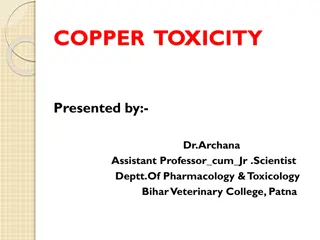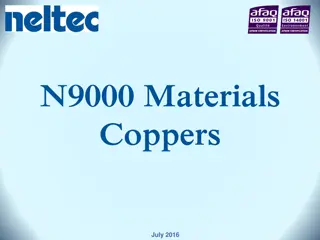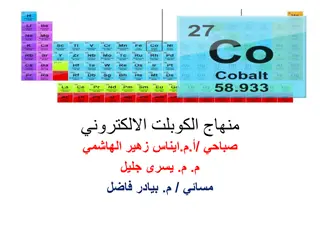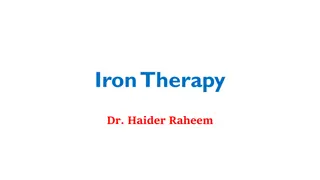Iron,Cobalt and Copper deficiency
Iron, cobalt, and copper deficiencies are common in young animals, leading to various clinical manifestations. Diagnosis and treatment involve addressing the specific deficiencies with appropriate supplements. Understanding the etiology and pathogenesis of these deficiencies is crucial for effective management in veterinary practice.
Download Presentation

Please find below an Image/Link to download the presentation.
The content on the website is provided AS IS for your information and personal use only. It may not be sold, licensed, or shared on other websites without obtaining consent from the author. Download presentation by click this link. If you encounter any issues during the download, it is possible that the publisher has removed the file from their server.
E N D
Presentation Transcript
Iron,Cobalt and Copper deficiency Dr. Bipin Kumar Assistant Professor Department of Veterinary Medicine Bihar Veterinary College, Patna (Bihar Animal Sciences University, Patna)
Iron deficiency A dietary def. of iron causes anemia and failure to thrive. It occurs most commonly in young suckling piglets maintained indoors with no acess to iron in their diet.
Etilogy/Pathogenesis Young ones kept exclusively on milk. Milk suppose to be poor source of iron. Fe def. Less Hb in blood Hypoxia to tissues/organs Metabolic alteration and other clinical manifestation
Diagnosis/Treatment Hb RBC ,it is better index than the Hb. Iron def. Microcytic hypochromic anemia. Treatment with Iron- dextran,Iron gluconate, iron sorbito lcitric acid complex etc. 0.5-1gm elemental iron per week. Oral @2-4gm daily 2 weeks. Iron reach diet should be fed to animals (Ferrous sulphate 2-4gm daily) to minimize the incidence.
Cobalt def. Required for Vit B12 synthesis. The disease is characterised clinically by inappetance and loss of body weight Two forms of disease 1.Cost disease in sheep. 2. Wasting disease or enzootic marasmus. In cattle Co def.leads to in an inability to metabolize propionic acid. Treated with cobalt sulphate @1mg/kg I/M injection of Vit B12 @100-300 gm for lamb and kids.
Copper Deficiency It occurs primarily in young ruminants and clinically characterized by untriftiness,bleaching of hair,diarrhoea,lameness,demyelination of nerve in neonates,anemia and falling disease. Caused by primary and 2ry def.of Cu. Excess Mo,Zn,Fe,Pb and calcium carbonate are antagonist of Cu. Cu plays important role in various ways. some of them are given below.
1.On tissue- plays important role in oxidative process of tissue either supplementing cytochrome oxidase system on entering into their formation. -Ceruloplasmin is Cu containing enzyme through Cu exerts its physiological function. 2.Wool; Cu def leads to inadequate keratinization due probably to imperfect oxidation of thiol groups. 3.GI tract; Diarrhoea occurs due to 2ry cu def, specially in Mo excessiveness. 4.Anemia; in view of heavy hemosiderin deposit in tissues of Cu deficient animals, it is probable that Cu necessary for the reutilization of iron liberated from the normal breakdown of Hb. 5.Bone;Osteoporosis due to Cu def is caused by depression of osteoblastic activity. -There is marked overgrwth of epiphyseal cartilage especially at costochondral junction and in metatarsal bones. -This is accompanied by beading of ribs and enlargement of long bones.
6.Connective tissue; Cu is component of the enzyme lysyl oxidase secreted by the cells involve in the synthesis of elastin component of C.T. and has important function in maintening the integrity of capillary beds,ligaments & tendons. 7.Myocardial degeneration of falling disease. 8.Nervous system; demyelination of nerve. Copper-Mo-Sulphate relationship In ruminants these three from organic and inorganic sources can combine in the rument to form an unabsorbable triple complex ,copper tetrathiomolybdate and deplete the host Cu.
Copper deficiency syndrome in cattle 1. 2. 3. 2ry Cu def. Scouring is prominent signs in hyperMo. Falling disease; characterised by sudden throwing up their heads, bellow and fall. Peat scours (Teart) or spectacles disease of cattle and sheep; Signs are persistent diarrhoea with passage of watery, yellow-green to black faeces. The faeces are released without effort often without lifting the tail. Normal appetite with severe debilitation. The hair is rough and dipigmented and is manifested by redening or grey flecking especially around eye, thats why known as spectacles disease. Subclinical hypocuprosis General syndrome(primary Def) Unthriftiness, loss of milk yield,PPH and anemia in adult cattle.
Unthriftiness(pine); The earliest signs are stifness of gait. Epiphysis of the distal ends of the metacarpal and metatarsal bone enlarges,painful on palpation and lameness.
Cu def, in sheep Enzootic ataxia Lamb is affected. Ataxia and hind quarter muscle atrophy. Incordination of the hindlimb. Respiration and heart rate increases after excercise. Flexion of joints,knuckling over the fetlock. Wobbling from hindquarter and finally fell down.
Swayback Congenital form Cerebrospinal form Incordination and erratic movements are more evident than the enzootic ataxia. Spastic paralysis. Blindness with softening and cavitation of the cerebral white matter.
Treatment CuSo4 @4gm for calves and 8-10gm for adult weekly for 3-5 weeks. Copper glycinate,methionate,heptanoate @400mg in cattle. 150mg in sheep I/M weekly for 3-5 weeks.
